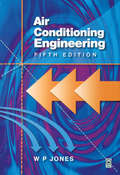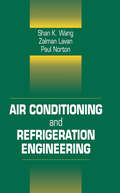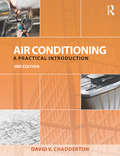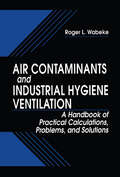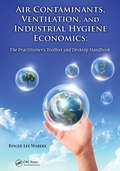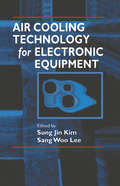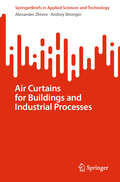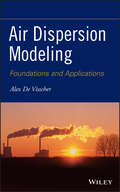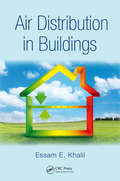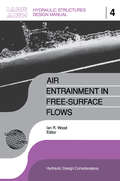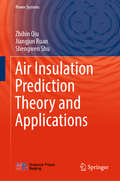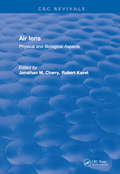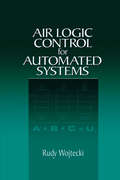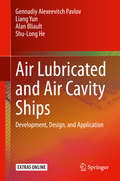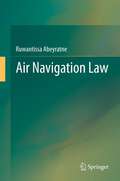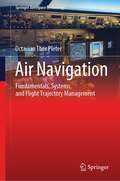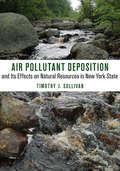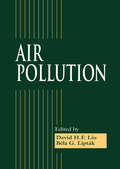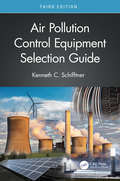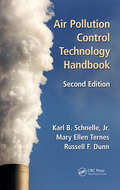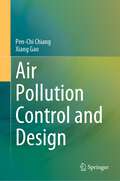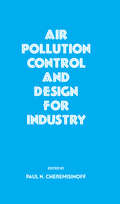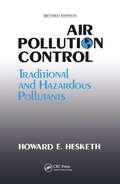- Table View
- List View
Air Conditioning Engineering
by W.P. JonesDesigned for students and professional engineers, the fifth edition of this classic text deals with fundamental science and design principles of air conditioning engineering systems. W P Jones is an acknowledged expert in the field, and he uses his experience as a lecturer to present the material in a logical and accessible manner, always introducing new techniques with the use of worked examples.
Air Conditioning and Refrigeration Engineering (Engineering Handbooks)
by Shan K. Wang, Zalman Lavan and Paul NortonAn air conditioning system consists of components and equipment arranged in sequential order to control and maintain an indoor environment. The goal is to provide a healthy and comfortable climate with acceptable air quality while being energy efficient and cost effective. Air Conditioning and Refrigeration Engineering covers all types of systems from institutional and commercial to residential.The book supplies the basics of design, from selecting the optimum system and equipment to preparing the drawings and specifications. It discusses the four phases of preparing a project: gathering information, developing alternatives, evaluating alternatives, and selling the best solution. In addition, the author breaks down the responsibilities of the engineer, design documents, computer aided design, and government codes and standards.Air Conditioning and Refrigeration Engineering provides you with an easy reference to all aspects of the topic. This resource addresses the most current areas of interest, such as computer-aided design and drafting, desiccant air conditioning and energy conservation. It is a thorough and convenient guide to air conditioning and refrigeration engineering.
Air Conditioning: A Practical Introduction
by David V. ChaddertonDavid Chadderton's Air Conditioning is the complete introduction and reference guide for students and practitioners of air conditioning design, installation and maintenance. The scientific principles involved are introduced with the help of case studies and exercises, and downloadable spreadsheets help you work through important calculations. New chapters on peak summertime air temperature in buildings without cooling systems, air duct acoustic calculations and air conditioning system cost enhance the usefulness to design engineers. Case studies are created from real life data, including PROBE post-occupancy reports, relating all of the theoretical explanations to current practice. Trends and recent applications in lowering energy use by air conditioning are also addressed, keeping the reader informed of the latest sustainable air conditioning technologies. Over 75 multiple choice questions will help the reader check on their progress. Covering both tropical and temperate climates, this is the ideal book for those learning about the basic principles of air conditioning, seeking to understand the latest technological developments, or maintaining a successful HVAC practice anywhere in the world.
Air Contaminants and Industrial Hygiene Ventilation: A Handbook of Practical Calculations, Problems, and Solutions
by RogerL. WabekeThe industrial hygienist is actively involved with the engineering community, particularly where the subject of industrial ventilation is concerned. While engineers concentrate on methods and techniques necessary to ensure maximum efficiency of a given system, the industrial hygienist concentrates on human health.Ventilation is one of the most widely used methods of controlling environmental eontaminates, and for this reason, industrial hygienists must have specific knowledge of the design of equipment and the principles which it operates.This informative text, written in easily understood language, will allow those without a mechanical engineering background to understand air calculation and ventilation problems. Industrial Hygiene Ventilation provides the industrial hygienist with a handy reference containing the equations, constants, conversions, and formulae that they will encounter in their day to day duties.
Air Contaminants, Ventilation, and Industrial Hygiene Economics: The Practitioner's Toolbox and Desktop Handbook
by Roger Lee WabekeThere is nothing more devastating to baseless opinions than good numbers. Air Contaminants, Ventilation, and Industrial Hygiene Economics: The Practitioner's Toolbox and Desktop Handbook helps you obtain "good numbers" on your quest to squash shabby opinions with sound advice. It details real-world applications of good numbers to foster improvement
Air Cooling Technology for Electronic Equipment
by Sung Jin Kim Sang Woo LeeClear your bookcase of references containing bits and pieces of useful information and replace them with this thorough, single-volume guide to thermal analysis. Air Cooling Technology for Electronic Equipment is a helpful, practical resource that answers questions frequently asked by thermal and packaging engineers grappling with today's demand for increased thermal control in electronics. Superbly organized for quick reference, the book dedicates each chapter to answering fundamental questions, such as: What is the optimal spacing between the printed circuit boards? What is a good estimate of the heat transfer coefficient and the associate pressure drop for forced convection over package arrays? How are heat transfer and fluid flow characteristics in the entrance region different from those in the fully developed region? What is the effect of substrate conduction on convection cooling?The chapters, written by engineers and engineering educators who are experts in electronic cooling, are packed with details and present the latest developments in air cooling techniques and thermal design guidelines. They provide problem-solving analyses that are jargon-free, straightforward, and easy to understand. Air Cooling Technology for Electronic Equipment is a handy source of technical information for anyone who wants to get the most out of air cooling.
Air Curtains for Buildings and Industrial Processes (SpringerBriefs in Applied Sciences and Technology)
by Alexander Zhivov Andrey StronginThis book is based on several decades of authors’ research and practical experience in the areas of industrial and commercial buildings ventilation and energy efficiency as well as in process optimization in different types of industrial facilities. The Book discusses different types of air curtains used around the world and describes design, applications, pros and cons and examples for each type of air curtain. The book is illustrated with schematics of air curtains and pictures from their real-life implementation from around-the -world. To compare various design of air curtains, authors propose several indicators/efficiency criteria, which address effectiveness of air curtains, their energy and performance efficiency. The target audience for this book are energy and process engineers and designers of large commercial and industrial facilities, warehouses, and hangars.
Air Dispersion Modeling: Foundations and Applications
by Alex De VisscherA single reference to all aspects of contemporary air dispersion modeling The practice of air dispersion modeling has changed dramatically in recent years, in large part due to new EPA regulations. Current with the EPA's 40 CFR Part 51, this book serves as a complete reference to both the science and contemporary practice of air dispersion modeling. Throughout the book, author Alex De Visscher guides readers through complex calculations, equation by equation, helping them understand precisely how air dispersion models work, including such popular models as the EPA's AERMOD and CALPUFF. Air Dispersion Modeling begins with a primer that enables readers to quickly grasp basic principles by developing their own air dispersion model. Next, the book offers everything readers need to work with air dispersion models and accurately interpret their results, including: Full chapter dedicated to the meteorological basis of air dispersion Examples throughout the book illustrating how theory translates into practice Extensive discussions of Gaussian, Lagrangian, and Eulerian air dispersion modeling Detailed descriptions of the AERMOD and CALPUFF model formulations This book also includes access to a website with Microsoft Excel and MATLAB files that contain examples of air dispersion model calculations. Readers can work with these examples to perform their own calculations. With its comprehensive and up-to-date coverage, Air Dispersion Modeling is recommended for environmental engineers and meteorologists who need to perform and evaluate environmental impact assessments. The book's many examples and step-by-step instructions also make it ideal as a textbook for students in the fields of environmental engineering, meteorology, chemical engineering, and environmental sciences.
Air Distribution in Buildings (Mechanical and Aerospace Engineering Series #54)
by Essam E. KhalilAir Distribution in Buildings is a concise and practical guide to air distribution system design and managing air conditioning systems in buildings. Making use of 40 years of experience in the design of air conditioning and ventilations systems, and other electromechanical services, this structured reference for built environment engineering offers
Air Entrainment in Free-surface Flow: IAHR Hydraulic Structures Design Manuals 4
by Ian R. WoodThis monograph is aimed at the practising hydraulic engineer. Work on it commenced at Professor Naudascher's instigation in 1982. Over the next six years all or some of the authors discussed progress at IAHR sponsored conferences at Esslingen, Melbourne, Lausanne and Beijing. With the authors scattered throughout the world, and all with other responsibilities, progress was bound to be slow. Completion was further delayed by the great increase in published technical literature in this area over the period 1982-1988. This literature continues to expand and with it our understanding of the air water flow phenomena. The monograph must therefore be seen as the authors' views on the state of the art around 1988. More recent references have been included for completeness.This monograph has been a joint effort with most authors making suggestions and contributions to more than one chapter. Nevertheless, the chapter authors are primarily responsible for the material in their chapters.Throughout the monograph symbols are defined when they are fist introduced and a list of symbols is included at the end of each chapter.Many other people have contributed to this monograph, but the authors would particularly like to acknowledge the assistance given by Professor John McNown who has read, commented on and improved the style of the complete monograph.
Air Force One: Protecting the President's Plane (High Security)
by Kaitlyn DulingAir Force One keeps the U.S. president safe while flying. Learn more about the features that protect this amazing plane. Also find out how team members protect the president as he travels on Air Force One.
Air Insulation Prediction Theory and Applications (Power Systems)
by Zhibin Qiu Jiangjun Ruan Shengwen ShuThis book proposes the air insulation prediction theory and method in the subject of electrical engineering. Prediction of discharge voltage in different cases are discussed and worked out by simulation. After decades, now bottlenecks of traditional air discharge theories can be solved with this book. Engineering applications of the theory in air gap discharge voltage prediction are introduced. This book serves as reference for graduate students, scientific research personnel and engineering staff in the related fields.
Air Ions: Physical and Biological Aspects
by Jonathan M. CharryAir Ions: Physical and Biological Aspects fully develops two areas that are important for a comprehensive understanding of the subject of air ions: (1) the physical/chemical nature of ions, and (2) their potential interaction with biological systems. The reader is led through a series of none chapter, the first five of which lay the basis for understanding ions in the context of naturally and artificially created environments. The final four chapters are well situated to discuss the literature and history connected with the search for ion-induced biological effects.
Air Logic Control for Automated Systems
by Rudy WojteckiAs industrial processes become more and more automated, Air Logic Control (ALC) becomes increasingly important. As the use of ALC becomes more widespread, the need for designers, engineers, and technicians with a working knowledge of ALC technology grows significantly. Air Logic Control for Automated Systems provides the means for anyone involved with control systems to acquire the knowledge and skills they need to implement and maintain ALC for automated manufacturing.The author focuses on the two types of ALC most often encountered: fluidics and Moving Parts Logic (MPL). He provides a thorough background on the subject, including the properties of compressible fluids, the fundamentals of pneumatics, and the fundamentals of logic systems, then delves into both moving parts and non-moving parts concepts and components. He discusses signal transmission, communications, electrical and electronic devices, plus the symbology, schematics, and flow diagrams related to ALC, and offers a complete overview of ALC system design. With this background established, the author presents three case studies of increasing complexity: a press control system, a parts sorting system, and a bottle filling system. These studies each offer a different approach to problem-solving and together they illustrate the alternative methods available in practice.Air Logic Control for Automated Systems thus offers technicians, engineers, and designers the foundation for understanding ALC. Armed with this knowledge, they are equipped to handle any number of implementation, programming, maintenance, and troubleshooting tasks with confidence.
Air Lubricated and Air Cavity Ships: Development, Design, and Application
by Alan Bliault Liang Yun Gennadiy Alexeevitch Pavlov Shu-Long HeAir Lubrication and Air Cavity Technology is a major development that has emerged in recent years as a means to reduce resistance and powering for many types of ships, and an efficient design for high speed marine vessels. This book introduces the mechanisms for boundary layer drag reduction and concepts studied in early research work. Air bubble and sheet lubrication for displacement vessels is outlined and the key projects introduced. Generation of low volume flow air cavities under the hull of displacement, semi displacement and planing vessels are introduced together with theoretical and empirical analysis and design methods. Resistance reduction, power reduction and fuel efficiency are covered for both displacement and high speed vessels. Air layer and air cavity effects on vessel static and dynamic stability are covered, linked to regulatory requirements such as IMO. Seaway motions and reduced impact load of high speed craft in waves are discussed including model test results. Integration of propulsion systems for optimum powering is summarized. A design proposal for a wave piercing air cavity craft is included in an appendix. A comprehensive listing of document resources and internet locations is provided for further research.
Air Navigation Law
by Ruwantissa AbeyratneThe aviation community, in which the International Civil Aviation Organization (ICAO), the International Air Transport Association (IATA) and the Civil Air Navigation Services Organization (CANSO) play leading roles, is hard at work in bringing aviation into the 21st Century. In doing so, the United States and Europe have taken proactive steps forward in introducing modernization, particularly in moving towards more efficient air traffic management systems within NextGen and SESAR. Elsewhere, in the fields of personnel licensing, rules of the air, accident investigation and aeronautical charts and information, significant strides are being made in moving from mere regulation to implementation and assistance calculated to make all ICAO member States self sufficient in international civil aviation. However, these objectives can be achieved only if the aviation industry has a sustained understanding of the legal and regulatory principles applying to the various areas of air navigation. This book provides that discussion. Some of the subjects discussed in this book are: sovereignty in airspace; flight information and air defence identification zones; rules of the air; personnel licensing; meteorological services; operations of aircraft; air traffic services; accident and incident investigation; aerodromes; efficiency aspects of aviation and environmental protection; aeronautical charts and information; the carriage of dangerous goods; and NextGen and SESAR . Except for NextGen and SESAR, these subjects form the titles of the Annexes to the Chicago Convention that particularly involve the rights and liabilities of the key players involved in air navigation.
Air Navigation: Fundamentals, Systems, and Flight Trajectory Management (Springer Aerospace Technology)
by Octavian Thor PleterThis book takes a new approach to air navigation, extending the classic scope of positioning and guidance to efficient and safe 4D flight trajectory management. Modern air navigation aims at flight trajectories optimisation. There is an infinite number of solutions to the classic navigation problem of flying from one airport to another, but most of them are wasteful of resources and even risky. Minimising all costs and risks incurred by the 4D flight trajectory makes air navigation both efficient and safe, which are key factors in air navigation services. Beyond minimising fuel burn and CO2, efficiency addresses non-CO2 emissions and noise. This is a visually intensive book, using examples and case studies to illustrate the concepts, the physics of navigation and the mathematical models involved. Numerical examples reflect its problem-solving nature. It is useful to aerospace students, engineers, pilots, air traffic controllers, technicians, and scientists curious about aviation.
Air Pollutant Deposition and Its Effects on Natural Resources in New York State
by Timothy J. SullivanEcosystem effects from air pollution in the Adirondacks, Catskills, and elsewhere in New York have been substantial. Efforts to characterize and quantify these impacts, and to examine more recent recovery, have focused largely on surface waters, soils, and forests. Lakes, streams, and soils have acidified. Estuaries have become more eutrophic. Nutrient cycles have been disrupted. Mercury has bioaccumulated to toxic levels. Plant species composition has changed. Some surface waters show signs of partial chemical recovery in response to emissions control programs, but available data suggest that soil chemistry may continue to deteriorate under expected future emissions and deposition. Resource managers, policymakers, and scientists now need to know the extent to which current and projected future emissions reductions will lead to ecosystem recovery.In this book, Timothy J. Sullivan provides a comprehensive synthesis of past, current, and potential future conditions regarding atmospheric sulfur, nitrogen oxides, ammonium, and mercury deposition; surface water chemistry; soil chemistry; forests; and aquatic biota in New York, providing much needed information to help set emissions reduction goals, evaluate incremental improvements, conduct cost/benefit analyses, and prioritize research needs. He draws upon a wealth of research conducted over the past thirty years that has categorized, quantified, and advanced understanding of ecosystem processes related to atmospheric deposition of strong acids, nutrients, and mercury and associated ecosystem effects. An important component of this volume is the new interest in the management and mitigation of ecosystem damage from air pollution stress, which builds on the "critical loads" approach pioneered in Europe and now gaining interest in the United States. This book will inform scientists, resource managers, and policy analysts regarding the state of scientific knowledge on these complex topics and their policy relevance and will help to guide public policy assessment work in New York, the Northeast, and nationally.
Air Pollutants in the Context of One Health: Fundamentals, Sources, and Impacts (The Handbook of Environmental Chemistry #134)
by Sylvester Chibueze Izah Matthew Chidozie Ogwu Abbas ShahsavaniThis book reviews air pollutants and their effects on human health, biodiversity, and environmental quality in the context of the One Health framework. Written by experts in the field, the book covers topics such as natural and anthropogenic sources of air pollutants, air pollutants classification based on their chemical composition, physical properties, and origins, and consequences of air pollution on ecosystems, wildlife, and human communities. In this book, readers will find a detailed examination of pollutants, such as particulate matter, volatile organic compounds, and greenhouse gases, and will learn about the mechanisms by which pollutants impact, for instance, the respiratory, cardiovascular, and neurological systems. The book highlights the need for understanding the different pollutants and their One Health effects as a foundation for developing effective regulations, emission controls, cleaner technologies, and promoting lifestyle changes. The book also offers a global perspective on air pollution, and discusses the disproportionate impacts of air pollution on vulnerable populations. In alignment with the United Nations Sustainable Development Goals (SDG), specifically SDG 3 (Good Health and Well-being), SDG 7 (Affordable and Clean Energy), and SDG 11 (Sustainable Cities and Communities), this book takes a focused approach to the One Health implications of various air pollutants and is an important contribution to the global effort to mitigate the impact of air pollution on human health, biodiversity security, and environmental quality. Together with its companion work “Sustainable Strategies for Air Pollution Mitigation”, this book is a valuable resource for students, researchers, policymakers, and anyone seeking a comprehensive perspective on this critical environmental and public health challenge.
Air Pollution
by David H.F. Liu and Béla G. LiptákWhether considered a threat to the health of humans in particular or of the ecosystem in general, the problem of air pollution affects us all. In addition to the 189 chemicals listed in the air toxins category of the 1990 Clean Air Act Amendments, smog, acid rain, ozone depletion, and global warming all arise from air pollution. You can debate the prime causes óacid rain, excessive lumbering or changes in the weather ó but the diminishing rainforest and the spreading desert speak for themselves.Air Pollution addresses the sources and results of these problems, and how they influence the environment. It surveys all aspects of management, including dispersion modeling, emission measurements, air quality and continuous emission monitoring, remote sensing, and stack sampling. In addition, the book explores methods of reduction and control, with particular attention to gaseous emission controls and odor control.This stellar resource addresses the prevention of pollution created by existing technology, and the design of future zero-emissions technology. A useful guide for engineers, students or anyone working for environmental protection, Air Pollution provides a solid foundation and presents a sound environmental philosophy.Béla G. Lipták speaks on Post-Oil Energy Technology on the AT&T Tech Channel.
Air Pollution Control Equipment Selection Guide
by Kenneth C. SchifftnerThis new edition of Air Pollution Control Equipment Selection Guide builds upon the successes of previous editions that developed a detailed discussion on various technologies used for air pollution control. This book covers a wide range of equipment and provides a good overview of the related principles and applications. A particularly valuable feature are the practical examples, not commonly available in other books. Based on the author’s fifty years of experience in applying and operating air pollution control equipment, this book provides easy-to-read information on basic air pollution control technology and is the quintessential resource for the busy engineer and for those who do not have formal training in air pollution control.FEATURES OF THE THIRD EDITION Uniform and consistent applications information for comparing the effectiveness of different technologies. Provides answers to questions about how to reduce operating costs and how to achieve peak performance. Concise descriptions of each equipment with diagnostics and testing suggestions. New chapters on optimization techniques that help readers deal with different types of hardware for better performance and efficacy.
Air Pollution Control Technology Handbook
by Karl B. Schnelle Jr. Russell F. Dunn Mary Ellen TernesA detailed reference for the practicing engineer, Air Pollution Control Technology Handbook, Second Edition focuses on air pollution control systems and outlines the basic process engineering and cost estimation required for its design. Written by seasoned experts in the field, this book offers a fundamental understanding of the factors resulting i
Air Pollution Control and Design
by Pen-Chi Chiang Xiang GaoThis book focuses specifically on the environmental issues related to the air pollution control and design. It is divided into four parts: (1) Fundamentals of air pollution control, (2) fundamentals of energy utilization, (3) gaseous control and design, and (4) particulate control and design, each consisting of four to six chapters. The topics covered in this book not only introduce the basic concepts of air pollution control and design but also address the fundamentals of energy utilization in the context of good engineering practice and policy instruments. It also features several innovative technologies and integrated methodologies relating to gaseous and particulate matter control and design. To facilitate technology integration and meet the need for comprehensive information on sustainable development, the book discusses a wide range of areas concerning the principles, applications, and assessment of air pollution control and design and thermodynamics, heat transfer, advanced combustion and renewable energy for energy utilization. It also features regulations and policy instruments adopted around the globe as well as several case studies. Presenting the emerging challenges, new concepts, innovative methodologies, and resolving strategies, as well as illustrative and inspiring case studies, it appeals to a wide range of readers, such as researchers, graduate students, engineers, policy makers, and entrepreneurs.
Air Pollution Control and Design for Industry
by PaulN. CheremisinoffPresents current methods for controlling air pollution generated at stationary industrial sources and provides complete coverage of control options, equipment and techniques. The main focus of the book is on practical solutions to air pollution problems.
Air Pollution Control: Traditional Hazardous Pollutants, Revised Edition
by Howard D. HeskethSince the first edition was printed in 1991, there have only been minor changes in air regulations. The opposing "trenches" used by environmental regulation proponents have deepened as each side increases their database. Agencies and environmental groups have backed off a little in issues such as bubble policies and enforcement time tables. This has made it extremely difficult for equipment vendors to anticipate industry requirements. Overall, the current market projections are not very favorable for the new equipment suppliers. In contrast, the service organizations are seeing increasing need for their help in areas such as dispersion modeling, troubleshooting and testing. Existing systems are being improved upon to keep them in operation. There remains a continuous need for up-to-date references and training materials to serve these needs, and it is for this purpose this revised edition is dedicated.
